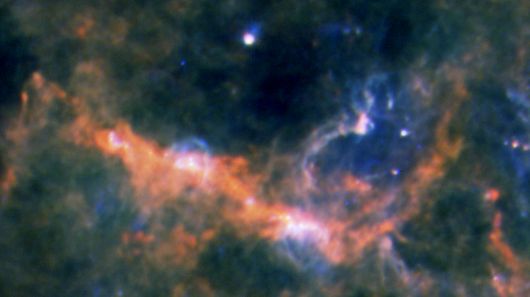Herschel images present a stunning insight into the distribution of matter in our galaxy
By Anthony Wood
June 1, 2015

Herschel Space Observatory image of filamentary structure G47 (Credit: ESA/Herschel/PACS/SPIRE/Ke Wang et al. 2015)
Three stunning new images from ESA's Herschel Space Observatory are providing new insights into how matter is distributed in our galaxy. Observations made by the orbital telescope have led astronomers to conclude that our galaxy is threaded with filamentary structures similar to those featured in the newly-released images, the smallest of which stretches across 170 light years of space.
Launched in May 2009, Herschel is essentially a giant infrared telescope with a primary mirror measuring 3.5 m (11.5 ft) in diameter. The observatory has been instrumental in discovering a series of vast filaments that appear to pervade the Milky Way. Herschel is particularly suited to seeking out the structures as the interstellar material from which they are composed shines brightly in the infrared medium.
Three filaments are captured in Herschel's newest images – G64, G47, and G49. The filaments are essentially enormous formations of gas and dust that, when imaged in false color, display beautiful and complex internal structures.
In Herschel's false-color images, cooler structures of gas and dust are pictured as red and yellow, while smaller blue and violet clumps of matter represent prime star birthing regions where the next generation of stellar behemoths are being created in a maelstrom of formation.
The three filaments captured by Herschel are truly enormous. Filament G49 is the largest of the newly-discovered formations, sitting roughly 18,000 light years away from Earth, and stretching an incredible 280 light years in length, and 5 light years in diameter. It is estimated that G49 has a total mass of around 80,000 times that of our Sun.
G47 stretches an impressive 250 light years, with a diameter of 10 light years and a mass of 20,000 Suns. Finally, G64, the most trivial of Herschel's most recent offering, still measures 170 light years in length with a diameter of 9 light years, and has a mass the equivalent of 5,000 times that of our parent star.
Thanks to Herschel, several of these unbelievably massive filaments have now been discovered in our own Milky Way. Astronomers believe that they were among the first structures to coalesce as interstellar matter clumped together, and that they represent a key element of the star creation process.
Source: ESA
http://www.gizmag.com/herschel-filaments-matter-distribution-milky-way/37756

